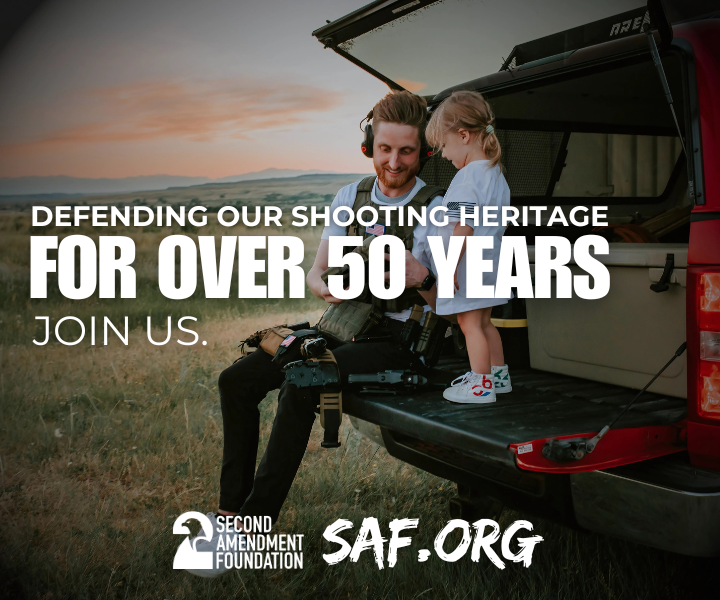
By Tanya Metaksa
What’s New—SCOTUS: Wolford v. Lopez; Case No. 24-1046: SCOTUS announced on Friday that it will take up Wolford v. Lopez as part of its upcoming term. This case challenges Hawaii’s version of a gun-carry restriction that gun-rights advocates call the “Vampire Rule: Duncan v. Bonta: Case No. 23-55805 Ninth Circuit: A petition for certiorari was filed on Aug. 20; California: Ninth Circuit: Hoffman v. Bonta: Case No. 25-5943: FPC members may apply for out-of-state carry permit before Jan. 1, 2026; Knife Rights, Inc. v. Rob Bonta; Case No. 24-5536: An amicus brief was filed on Sept. 26 by SECOND AMENDMENT FOUNDATION, CALIFORNIA RIFLE & PISTOL ASSOCIATION, INCORPORATED, AND SECOND AMENDMENT LAW CENTER, INC. In SUPPORT OF PLAINTIFFS-APPELLANTS; Texas: Fifth Circuit Knife Rights v. Pamela Bondi: Case No. 25-10754. On Oct. 1, the Firearms Policy Coalition, Inc., filed an amicus brief in this case; District Court; Butler v. Panela Bondi: Case No. 1:24-cv-975-CLM: This case challenged the ATF’s 2024 new rule implementing the federal rule 18 U.S.C. § 922(a)(1)(A)l Texas, Fifth Circuit: Firearms Policy Coalition v. Pamela Bondi: Case No. 4-24-CV-00565-O: The laws denying the carrying of firearms on USPS property in the Fifth Circuit are no longer valid.
SCOTUS
Wolford v. Lopez; Case No. 24-1046
SCOTUS announced on Friday that it will take up Wolford v. Lopez as part of its upcoming term. This case challenges Hawaii’s version of a gun-carry restriction that gun-rights advocates call the “Vampire Rule.” The question that SCOTUS will seek to resolve is:
“Whether the Ninth Circuit erred in holding, in direct conflict with the Second Circuit, that Hawaii may presumptively prohibit the carry of handguns by licensed concealed carry permit holders on private property open to the public unless the property owner affirmatively gives express permission to the handgun carrier?”
The provision under review changes the traditional permission system for carrying guns onto publicly accessible private property such as stores, restaurants, and parks, by legally requiring licensed gun owners to obtain explicit consent from the property owner before carrying a firearm there. This case gives the Court its first opportunity to apply its landmark 2022 decision in New York State Rifle & Pistol Association v. Bruen, which confirmed an individual’s right to carry firearms in public for self-defense. Over three days, three different commentators analyzed this legal development. These include a newsletter from The Reload, a blog post from the Duke Center for Firearms Law, and a YouTube video by constitutional lawyer Mark Smith, each offering different perspectives on how the case impacts Second Amendment law. Collectively, these sources highlight the novelty of the rule, its conflict with historical practices, and the potential for the Court to clarify Bruen’s framework amid conflicting decisions across circuits.
The Reload’s members’ newsletter, authored by Jake Fogleman, presents Wolford as a key test of Bruen‘s legacy. Fogleman explains how the Ninth Circuit upheld Hawaii’s law in September 2024, referencing 18th- and 19th-century anti-poaching laws as historical examples, while striking down California’s stricter version. He compares this to the Second and Third Circuits’ rulings after Rahimi, which declared similar rules in New York and New Jersey unconstitutional due to lack of historical backing. Fogleman criticizes the Vampire Rule as a “de facto gun ban” that undermines public carry rights, echoing Justice Thomas’s warnings in Bruen against overly broad “sensitive places.” He predicts a win for gun rights, highlighting the Ninth Circuit’s uniqueness and the rule’s broad daily impact on carriers.
In contrast, the Duke Center for Firearms Law blog post offers a more academic and neutral analysis, focusing on the legal implications and historical context. The authors dissect the Ninth Circuit’s reliance on a 1771 New Jersey law and an 1865 Louisiana statute—dubbed “dead ringers” for default no-carry presumptions—as pivotal to upholding Hawaii’s law. They note the circuit split, with other courts dismissing these analogies for limited scope or discriminatory origins (e.g., Louisiana’s Black Codes). The post examines Bruen‘s text-and-history test, questioning how many analogues are sufficient and whether post-Reconstruction laws qualify. Implications include potential clarification on excluding biased historical sources or setting evidentiary floors for gun regulations. The authors speculate on the mootness issue if Hawaii repeals the law, akin to New York’s pre-Bruen maneuver, and suggest that the narrow cert question limits broader doctrinal shifts.
Mark Smith’s YouTube video on the Four Boxes Diner channel adopts a staunchly pro-Second Amendment tone, labeling the Vampire Rule a “gimmick” by anti-gun advocates. Smith argues that it inverts longstanding presumptions, allowing carrying on private property unless prohibited, which renders self-defense impractical in everyday spaces, such as stores. He critiques historical analogies as irrelevant (e.g., anti-poaching laws tied to hunting, rather than peaceful carry) and highlights the Trump-era DOJ’s amicus brief in support of cert. Referencing his own scholarship, Smith emphasizes the founding era over later periods. While not directly addressing Rahimi, he ties the rule to post-Bruen state overreaches. Predicting a “slam dunk” win for gun rights due to the interlocutory cert grant, Smith warns of mootness risks but emphasizes the enduring precedent value of a ruling.
These discussions converge on three key themes: the practical burden of the Vampire Rule on public carry, the Ninth Circuit’s divergence from its peers, and the need for refinement of the Bruen standard. All reference historical laws’ adequacy, with Fogleman and Smith viewing them as weak justifications, while Duke’s post delves deeper into their interpretive debates. Differences emerge in tone and depth—Fogleman’s journalistic critique emphasizes policy impacts, Duke’s balanced scholarship probes doctrinal nuances, and Smith’s advocacy rallies viewers with predictions of victory.
Strengths include Fogleman’s circuit comparisons and Smith’s DOJ insights; weaknesses lie in potential biases, as Smith and Fogleman lean pro-gun without providing counterarguments, unlike Duke’s more moderate stance.
Overall, these commentaries shed light on Wolford‘s role in policing post-Bruen innovations, potentially curbing state restrictions while solidifying public carry protections. A favorable ruling could invalidate similar laws nationwide, but the issue of mootness looms as a wildcard. As oral arguments approach, these discussions underscore the high stakes of the case in striking a balance between rights and regulation in a divided legal landscape.
The following have filed amici curiae: The National Association For Gun Rights, Second Amendment Law Center, et al., Foundation for Moral Law, STATES OF MONTANA, IDAHO, 23 OTHER STATES, AND THE ARIZONA LEGISLATURE, The Buckeye Institute, and The Association of New Jersey Rifle & Pistol Clubs, Inc.
Duncan v. Bonta: Case No. 23-55805 Ninth Circuit: A petition for certiorari was filed on Aug. 20. The petition states:“This case challenges California’s unconstitutional ban on standard-capacity magazines. CRPA is asking SCOTUS to finally weigh in to end certain biased courts’ defiance of the clear precedent set by SCOTUS in the Bruen case.”
Background: On March 20, the Ninth Circuit, sitting en banc in San Francisco, issued a 7-4 decision upholding California’s ban on large-capacity magazines (LCMs)—defined as magazines capable of holding more than 10 rounds of ammunition. The majority concluded that this ban is constitutional under the Second Amendment. The case, Duncan v. Bonta, has been a long-running challenge to California’s restrictions, originally stemming from a 2016 voter-approved law (Proposition 63) and earlier statutes limiting magazine capacity. On April 8, CRPA filed a motion to stay the mandate, protecting those grandfathered magazines that were purchased before the complete ban and during “Freedom Week,” which was granted on April 10, 2025,by the Ninth Circuit.
Court of Appeals
California: Ninth Circuit
Hoffman v. Bonta: Case No. 25-5943: FPC members may apply for out-of-state carry permit before Jan. 1, 2026
“The District Court granted in part Plaintiffs’ Motion for Summary Judgment. The District Court held that the in-state residency requirement violates the Second Amendment. The District Court declined to reach the merits of the Privileges-and-Immunities challenge. The parties then offered two competing injunctions for the District Court’s review. Plaintiffs’ injunction only addressed the in-state residency requirement: Attorney General Bonta also amended several other parts of California firearms law to account for non-residency applicants. The District Court adopted Plaintiffs’ proposed injunction. The case has been settled regarding those claims.”
On Oct. 6, FPC posted the following on their website: “(October 6, 2025) — Because of the court’s injunction in our major FPC victory in Hoffman v. Bonta, FPC members outside of California can now apply for a carry license to any licensing authority in California—without being forced to disclose where in California they plan to spend their time or apply where they intend to travel. We built this page to help you secure your California carry license—and make California anti-gun politicians like Gavin Newsom cry. To that end, below is some important information and links to documents, as well as a list of carry license application websites for California’s 58 county sheriffs.”
They continue…
“Thanks to the Hoffman injunction, California’s non-resident carry ban is dead. And right now, FPC members can apply with any sheriff or police chief in the state. According to the court’s order, “Defendant Attorney General Rob Bonta … and any other persons who are in active concert or participation with Defendant, are hereby permanently enjoined from enforcing California Penal Code sections 26150(a)(3) and 26155(a)(3) as to CCW applications submitted by Plaintiff Firearms Policy Coalition’s members who are not residents of California, including the named Individual Plaintiffs.”
Knife Rights, Inc. v. Rob Bonta; Case No. 24-5536
An amicus brief was filed on September 26, 2025, by SECOND AMENDMENT FOUNDATION, CALIFORNIA RIFLE & PISTOL ASSOCIATION, INCORPORATED, AND SECOND AMENDMENT LAW CENTER, INC. In SUPPORT OF PLAINTIFFS-APPELLANTS. In the announcement, Attorney Chuck Michel wrote: “Our filing explains why California’s ban on common knives violates the Supreme Court’s decision in Bruen and cannot stand under the Second Amendment.
“This case isn’t just about knives—it’s about holding government accountable when it ignores constitutional protections and attempts to ban arms commonly owned by law-abiding citizens.”
Texas: Fifth Circuit
Knife Rights v. Pamela Bondi: Case No. 25-10754
On Oct. 1, the Firearms Policy Coalition, Inc. (FPC), filed an amicus brief in this case with the Fifth Circuit Court of Appeals, followed by the NRA the next day. FPC’s brief discusses the terms “in common use” and “dangerous and unusual,” while the NRA’s brief argues that all arms regulations must be justified by historical tradition. A court hearing is scheduled for Oct.10.
District Court
Butler v. Panela Bondi: Case No. 1:24-cv-975-CLM: This case challenged the ATF’s 2024 new rule implementing the federal regulation 18 U.S.C. § 922(a)(1)(A), which states it is unlawful for anyone “except a licensed importer, licensed manufacturer, or licensed dealer, to engage in the business of importing, manufacturing, or dealing in firearms.” On Sept. 30, Judge Corey I. Maze ruled in favor of the plaintiffs.
Texas, Fifth Circuit
Firearms Policy Coalition v. Pamela Bondi: Case No. 4-24-CV-00565-O
On Sept. 20, Judge Reed O’Connor issued a ruling:
1. 2. 39 C.F.R. § 232.1(1) is unconstitutional under the Second Amendment with respect to Plaintiffs’ (and their members) possession and carrying of firearms inside of an ordinary United States Post Office or the surrounding Post Office property.
2. 18 U.S.C. § 930(a) is unconstitutional under the Second Amendment with respect to Plaintiffs’ (and their members) possession and carrying of firearms inside of an ordinary United States Post Office or the surrounding Post Office property
The laws denying the carrying of firearms on USPS property in the Fifth Circuit are no longer valid.


